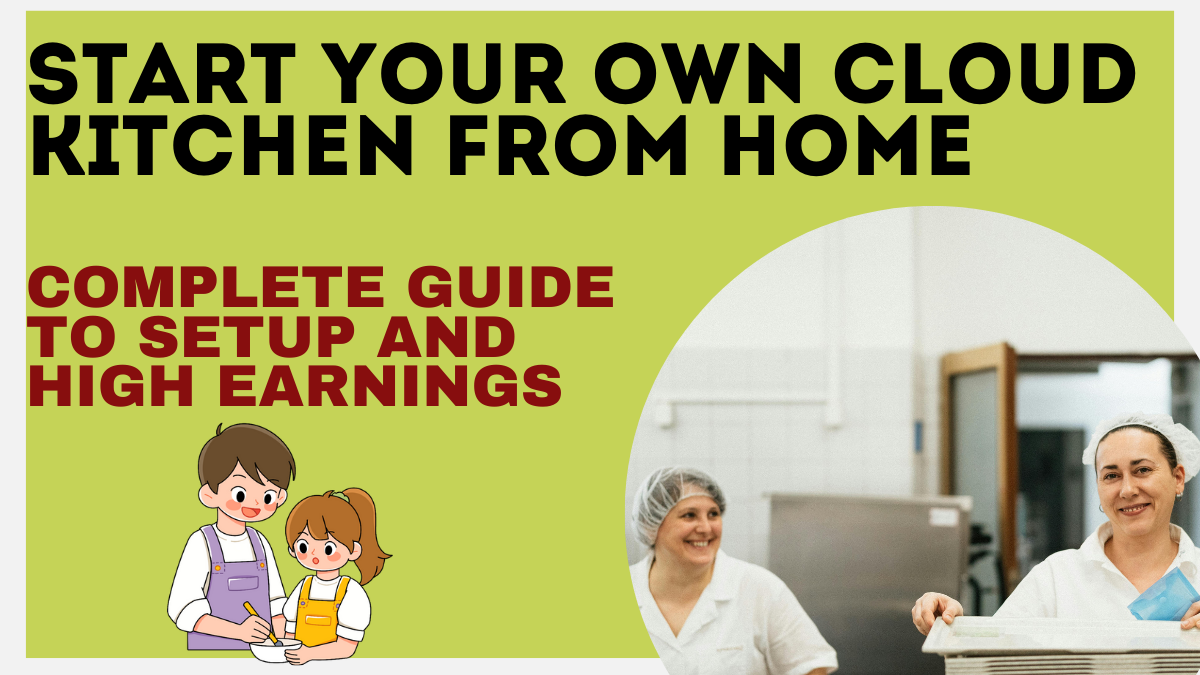The food delivery industry in India is growing at lightning speed in 2025, driven by platforms like Zomato, Swiggy, and ONDC (Open Network for Digital Commerce). One of the fastest-growing segments within this industry is the cloud kitchen model. A cloud kitchen, also known as a ghost kitchen or virtual restaurant, operates without dine-in facilities and focuses solely on online food delivery.
For entrepreneurs and homemakers looking to start a low-investment business with high returns, a home-based cloud kitchen in 2025 is one of the most lucrative opportunities.

Why Cloud Kitchens Are Popular in 2025
-
Low Startup Cost: No need for expensive interiors or dine-in spaces.
-
High Profit Margins: Focus on food quality and delivery, reducing overheads.
-
Rising Food Delivery Demand: Millions of Indians prefer ordering food online regularly.
-
Scalability: Easy to expand into multiple brands from the same kitchen.
According to industry reports, India’s cloud kitchen market is expected to grow fivefold by 2030, making 2025 the right time to enter.
Step-by-Step Setup Guide for a Home-Based Cloud Kitchen
1. Choose Your Food Niche
Pick a menu that matches local demand. Popular categories in 2025 include:
-
North Indian and South Indian meals.
-
Fast food (burgers, rolls, pizzas).
-
Healthy meal boxes.
-
Regional delicacies and snacks.
2. Register Your Business
Even a home-based kitchen requires basic registrations:
-
FSSAI License (mandatory for food safety).
-
GST Registration (if annual turnover exceeds ₹20 lakh).
-
Local municipal health permits if required.
3. Kitchen Setup
-
Invest in basic cooking equipment (stoves, ovens, utensils).
-
Ensure proper hygiene and ventilation.
-
Use separate storage for raw materials.
Estimated setup cost: ₹1–2 lakh for a small home kitchen.
4. Partner with Delivery Platforms
Register your brand on platforms like:
-
Swiggy
-
Zomato
-
ONDC network apps
These platforms will handle delivery logistics, allowing you to focus on cooking.
5. Branding and Packaging
-
Create a unique brand identity with logo and food name.
-
Use eco-friendly packaging that keeps food fresh.
-
Attractive packaging increases customer satisfaction and repeat orders.
6. Marketing Your Cloud Kitchen
-
Promote via Instagram, Facebook, and WhatsApp groups.
-
Offer introductory discounts to attract first-time buyers.
-
Encourage customer reviews for credibility.
Investment Required
Setting up a home-based cloud kitchen in 2025 is relatively affordable:
-
Kitchen equipment: ₹50,000 – ₹1 lakh
-
Licensing and permits: ₹10,000 – ₹20,000
-
Packaging and branding: ₹25,000 – ₹50,000
-
Marketing: ₹20,000 – ₹30,000
Total Initial Investment: Around ₹1.5–2.5 lakh
This makes it one of the best low-cost businesses with high earning potential.
Earning Potential from Cloud Kitchen in 2025
Earnings depend on order volume and pricing.
-
Average Order Value (AOV): ₹250–₹400
-
Daily Orders: 30–50 for small kitchens
-
Monthly Revenue: ₹2.5–5 lakh
-
Profit Margin: 25–30% after expenses
With good branding and consistent quality, earnings can grow quickly.
Challenges to Consider
-
High Competition: Many home kitchens and established restaurants are in the market.
-
Delivery Dependence: Platforms charge commissions (15–30%).
-
Consistency: Customers expect uniform taste and quality.
-
Licensing Delays: FSSAI approval may take weeks.
Overcoming these challenges with proper planning ensures long-term success.
Future of Cloud Kitchens in India
In 2025, multi-brand cloud kitchens are trending—where one kitchen runs multiple food brands targeting different cuisines. AI-driven apps also help analyze customer preferences, allowing cloud kitchens to adapt menus dynamically.
With rising urbanization, long working hours, and convenience-focused lifestyles, the cloud kitchen business will only expand further in the coming years.
Key Takeaways
The Home-Based Cloud Kitchen Business 2025 is an affordable and profitable venture for aspiring entrepreneurs. With minimal investment, high scalability, and growing food delivery demand, it offers steady monthly income and long-term sustainability.
If you have cooking skills and entrepreneurial drive, September 2025 is the perfect time to launch your home-based cloud kitchen.
FAQs
What is the minimum investment needed for a home-based cloud kitchen in 2025?
You can start with as little as ₹1.5–2.5 lakh, covering equipment, licenses, and branding.
Do I need an FSSAI license for a home kitchen?
Yes, an FSSAI license is mandatory, even for small-scale food businesses.
How much can I earn monthly from a cloud kitchen?
Small kitchens earn between ₹2.5–5 lakh per month, with profit margins of 25–30%.
Can I run multiple brands from one cloud kitchen?
Yes, you can operate multiple brands targeting different cuisines using the same kitchen setup.
Which platforms should I partner with for delivery?
Popular platforms include Swiggy, Zomato, and ONDC apps, which provide wide customer reach.
Click here to know more.
